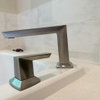I'm looking into EcoWater's 3500 refiner. It has carbon and resin within the same tank. I read a few threads that talked about how resin and carbon don't mix (Excerpt1). I asked a EcoWater rep and go the following rebuttal. Does the rebuttal have any ground? Never having to recharge the carbon doesn't sound right. Is this possible? Infinite regenerating source of carbon?
Except 1 (don't remember where I got it from):
I agree that carbon and resins should not be mixed. They are basically the same specific gravity and will blend during backwashings. The advantage of removing chlorine to protect the resins is soon lost. Moreover, the resins are hard and the carbon brittle. The resin will grind the carbon into fines and they will be backwashed out every time it regenerates. There is usually little need to 'replace' carbon as it is mostly gone, depleted.
Moreover, the resins are hard and the carbon brittle. The resin will grind the carbon into fines and they will be backwashed out every time it regenerates. There is usually little need to 'replace' carbon as it is mostly gone, depleted.
Rebuttal 1
Industry standards have the backwash on water softener/refiner washing from top to bottom which means, the brine solution is washed over the resin and flows down. This can create channeling where the system mixes carbon and resins and problems occur. EcoWater backwashes from the bottom up not the top down I agree that carbon and resins should not be mixed. They are basically the same specific gravity and will blend during backwashings. The advantage of removing chlorine to protect the resins is soon lost.
Furthermore the carbon unit never needs to be recharged.











User
MTech8Original Author
Related Professionals
Fish Hawk Handyman · Citrus Park Kitchen & Bathroom Remodelers · Elk Grove Kitchen & Bathroom Remodelers · Emeryville Kitchen & Bathroom Remodelers · Idaho Falls Kitchen & Bathroom Remodelers · Lakeside Kitchen & Bathroom Remodelers · Linton Hall Kitchen & Bathroom Remodelers · Martha Lake Kitchen & Bathroom Remodelers · Oceanside Kitchen & Bathroom Remodelers · Oklahoma City Kitchen & Bathroom Remodelers · Payson Kitchen & Bathroom Remodelers · Southampton Kitchen & Bathroom Remodelers · Joppatowne Kitchen & Bathroom Remodelers · Glenn Heights Kitchen & Bathroom Remodelers · Prairie Village Kitchen & Bathroom RemodelersUser
User
MTech8Original Author